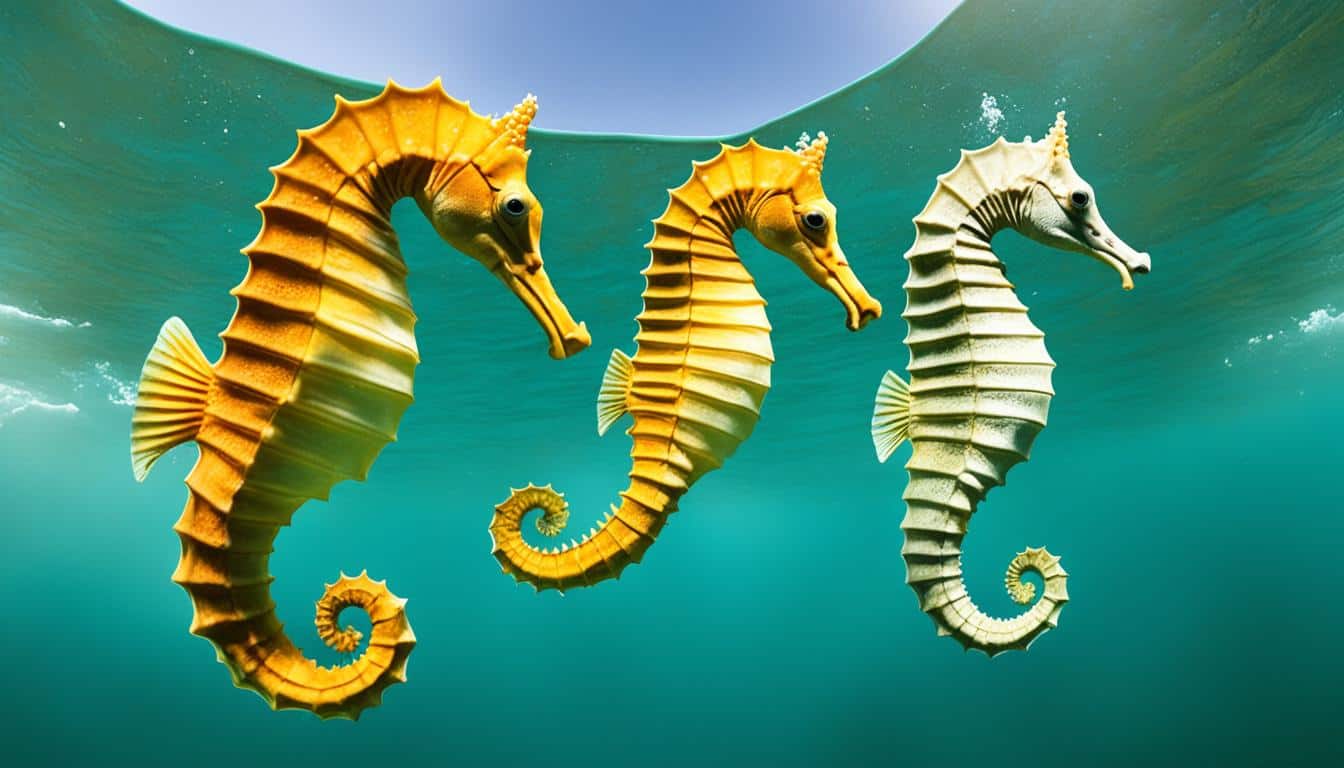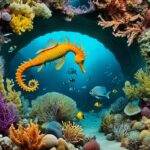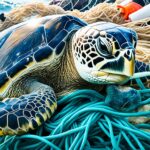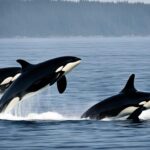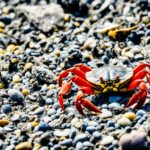Seahorses are amazing sea creatures, but they are in danger. They face many threats that put their survival at risk. These threats include overfishing, habitat destruction, pollution, and climate change.
Every year, over 70 million seahorses are caught, which hurts their numbers. The illegal trade of seahorses also adds to their problems. It’s important to understand these threats to help protect seahorses.
Overview of Seahorses and Their Unique Characteristics
Seahorses are fascinating marine creatures known for their unique traits and behaviors. They stand out with their upright swimming style and curled tails. These features make them stand out among other fish. Exploring their biological structure of seahorses shows how they’ve adapted to live in different water environments.
Biological Structure and Adaptations
The biological structure of seahorses is quite interesting. They have bony plates covering their bodies instead of scales. This shell-like covering protects them and helps them move and hide. Their long, horse-like snouts let them suck in small prey like zooplankton. These traits are key to their survival in changing environments.
Behavior and Reproductive Habits
Seahorse behavior is also quite fascinating, especially their seahorse reproductive habits. They form long-lasting monogamous relationships and perform complex courtship dances. A unique part of their reproduction is when the male gets pregnant, carrying eggs in a pouch until they hatch. This shows how important it is to saving seahorses and protect their habitats.
What threats do seahorses face?
Seahorses face many threats that affect their survival. One big issue is the overfishing of seahorses. This is made worse by bycatch from fishing gear. Also, the illegal trade of seahorses is a big problem.
Direct Exploitation: Overfishing and Bycatch
Seahorses are being caught more and more due to non-selective fishing. Shrimp trawling is a big part of this. Many seahorses get caught by accident and don’t make it.
About 70 million seahorses are lost each year this way.
Illegal Trade Impacting Seahorse Populations
Seahorses are still being traded illegally. This is because people want them for traditional medicine and aquariums. Laws like the Convention on International Trade in Endangered Species try to stop this. But, it’s hard to enforce these laws.
This illegal trade hurts marine life and makes seahorses harder to find. We need to act fast to protect them and keep the ocean healthy.
| Threat | Details | Impact on Population |
|---|---|---|
| Overfishing | Non-selective fishing methods, particularly shrimp trawling | Severe decline due to unintentional capture |
| Bycatch | Approximately 70 million seahorses caught annually | Significant loss to overall population sustainability |
| Illegal Trade | Demand for medicinal use and aquarium displays | Contributes to continued population decline |
The Role of Habitat Destruction in Seahorse Decline
Habitat destruction is a big problem for seahorses. These marine animals need specific places to live. Seagrass beds and coral reefs are crucial for their survival. But, human activities like urbanization and coastal development are threatening these places.
This puts seahorses and the health of marine life at risk.
Specific Habitats Affected: Seagrass Beds and Coral Reefs
Seagrass beds and coral reefs are key for seahorses. They are where seahorses breed and find safety from predators. But, as seahorse habitat destruction grows, these important places are disappearing.
This threatens not just seahorses but many other sea creatures that depend on them.
Effects of Urbanization and Coastal Development
The impact of urbanization on seahorses is worrying. Coastal projects lead to more sediment, which harms corals and seagrasses. This makes life harder for marine life and reduces food for seahorses.
Working to protect seahorses means saving their homes. We need to keep the places that let them live and thrive.

| Habitat Type | Importance for Seahorses | Threats |
|---|---|---|
| Seagrass Beds | Breeding ground, food source, shelter | Urbanization, pollution, coastal development |
| Coral Reefs | Protection from predators, habitat structure | Climate change, overfishing, habitat destruction |
Impact of Marine Pollution on Seahorses
Marine pollution is a big threat to seahorses. It comes from things like agricultural runoff and plastic waste in the ocean. This pollution harms seahorses by making their homes less safe and healthy.
Runoff from farms can cause harmful algae to grow, making the water hard for seahorses to breathe. Seahorses also eat plastic by mistake, which can make them very sick. This makes it harder to keep seahorses safe from pollution.
Pollution Types: Nutrient Runoff and Plastic
Climate change and seahorses are connected in ways that affect their survival. Pollution is making their homes worse, like seagrass beds. These beds are key for seahorses to live and have babies.
When seahorses eat plastic, they can get very sick. This makes it hard for them to survive and be healthy. It’s a big problem for seahorses trying to live in their ocean homes.
Long-term Effects of Oil Spills on Seahorse Habitats
Oil spills are a big disaster for seahorses. The Deepwater Horizon spill showed how fast oil can destroy their homes. Seahorses rely on places like seagrass beds to live and have babies.
Oil spills can change these places, make it hard for seahorses to have babies, and even kill them. We need to understand how pollution hurts seahorses and work to stop it. This will help protect these amazing sea creatures.
FAQ
What are the main threats faced by seahorses?
Seahorses face many threats, like overfishing and habitat destruction. Illegal trade, marine pollution, and climate change also harm them. These threats lead to fewer seahorses and make it hard to protect them.
How does overfishing impact seahorse populations?
Overfishing hurts seahorses a lot. Non-selective fishing, like shrimp trawling, catches about 70 million seahorses yearly. This harms their numbers a lot.
What role does illegal trade play in seahorse decline?
Illegal seahorse trade is a big problem. It’s driven by demand for traditional medicine and aquariums. Despite CITES regulations, it still hurts their numbers a lot.
How does habitat destruction affect seahorses?
Habitat destruction hurts seahorses a lot. Things like urbanization and coastal development damage their homes, like seagrass beds and coral reefs. This reduces where they live and find food.
What types of marine pollution threaten seahorse habitats?
Marine pollution is a big threat. Things like agricultural runoff, plastics, and oil spills harm their homes. This makes the water bad, lowers their chances of having babies, and increases deaths.
What can be done to protect seahorses?
We need to protect seahorses with good conservation plans. This includes saving their homes, better fishing rules, and less pollution. These steps are key to keeping seahorses alive in the wild.
How does climate change impact seahorses?
Climate change is bad news for seahorses. It brings warmer oceans, acid water, and less habitat. This makes them more likely to disappear and weakens their homes.
Why is it important to understand seahorse reproductive habits?
Knowing how seahorses have babies is important for saving them. Their unique way of pregnancy shows they need special homes. It also shows how delicate their lives are.

